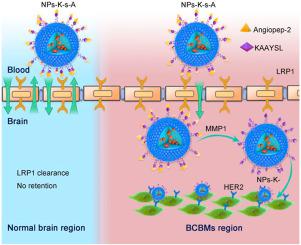Acta Pharmaceutica Sinica B ( IF 14.7 ) Pub Date : 2020-10-21 , DOI: 10.1016/j.apsb.2020.10.015 Naveed Ullah Khan , Jiang Ni , Xiufeng Ju , Tongtong Miao , Haiyan Chen , Liang Han

|
Breast cancer brain metastases (BCBMs) are one of the most difficult malignancies to treat due to the intracranial location and multifocal growth. Chemotherapy and molecular targeted therapy are extremely ineffective for BCBMs due to the inept brain accumulation because of the formidable blood‒brain barrier (BBB). Accumulation studies prove that low density lipoprotein receptor-related protein 1 (LRP1) is promising target for BBB transcytosis. However, as the primary clearance receptor for amyloid beta and tissue plasminogen activator, LRP1 at abluminal side of BBB can clear LRP1-targeting therapeutics. Matrix metalloproteinase-1 (MMP1) is highly enriched in metastatic niche to promote growth of BCBMs. Herein, it is reported that nanoparticles (NPs-K-s-A) tethered with MMP1-sensitive fusion peptide containing HER2-targeting K and LRP1-targeting angiopep-2 (A), can surmount the BBB and escape LRP1-mediated clearance in metastatic niche. NPs-K-s-A revealed infinitely superior brain accumulation to angiopep-2-decorated NPs-A in BCBMs bearing mice, while comparable brain accumulation in normal mice. The delivered doxorubicin and lapatinib synergistically inhibit BCBMs growth and prolongs survival of mice bearing BCBMs. Due to the efficient BBB penetration, special and remarkable clearance escape, and facilitated therapeutic outcome, the fusion peptide-based drug delivery strategy may serve as a potential approach for clinical management of BCBMs.
中文翻译:

逃离无足月LRP1介导的清除,以促进纳米颗粒脑传递和脑转移治疗
由于颅内位置和多灶性生长,乳腺癌脑转移瘤(BCBM)是最难治疗的恶性肿瘤之一。由于无力的血脑屏障(BBB),化学治疗和分子靶向治疗对BCBM而言极为无效,因为它们无能为力地积聚了大脑。积累的研究证明,低密度脂蛋白受体相关蛋白1(LRP1)是BBB转胞作用的有希望的目标。但是,作为淀粉样β和组织纤溶酶原激活剂的主要清除受体,BBB腔侧的LRP1可以清除靶向LRP1的治疗药物。基质金属蛋白酶-1(MMP1)在转移生态位中高度富集,以促进BCBMs的生长。在此处,据报道,纳米粒子(NPs-KsA)与含有靶向HER2的K和靶向LRP1的angiopep-2(A)的MMP1敏感的融合肽束缚在一起,可以超越BBB并逃脱转移小生境中LRP1介导的清除。NPs-KsA揭示了在携带BCBM的小鼠中,大脑的蓄积要比用Angiopep-2装饰的NPs-A优越得多,而在正常小鼠中,大脑的蓄积是可比的。递送的阿霉素和拉帕替尼协同抑制BCBMs的生长并延长带有BCBMs的小鼠的存活。由于有效的BBB渗透,特殊和显着的清除逃逸以及促进治疗效果,基于融合肽的药物递送策略可能成为BCBMs临床管理的潜在方法。NPs-KsA揭示了在携带BCBM的小鼠中,大脑的蓄积要比用Angiopep-2装饰的NPs-A优越得多,而在正常小鼠中,大脑的蓄积是可比的。递送的阿霉素和拉帕替尼协同抑制BCBMs的生长并延长带有BCBMs的小鼠的存活。由于有效的BBB渗透,特殊和显着的清除逃逸以及促进治疗效果,基于融合肽的药物递送策略可能成为BCBMs临床管理的潜在方法。NPs-KsA揭示了在携带BCBM的小鼠中,大脑的蓄积要比用Angiopep-2装饰的NPs-A优越得多,而在正常小鼠中,大脑的蓄积是可比的。递送的阿霉素和拉帕替尼协同抑制BCBMs的生长并延长带有BCBMs的小鼠的存活期。由于有效的BBB渗透,特殊和显着的清除逃逸以及促进治疗效果,基于融合肽的药物递送策略可能成为BCBMs临床管理的潜在方法。











































 京公网安备 11010802027423号
京公网安备 11010802027423号